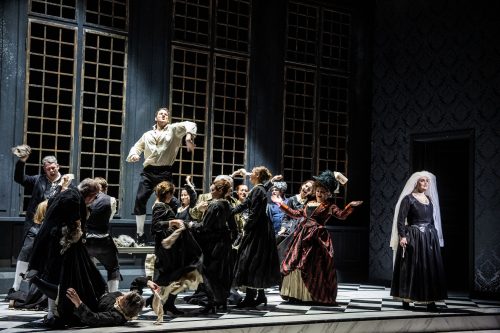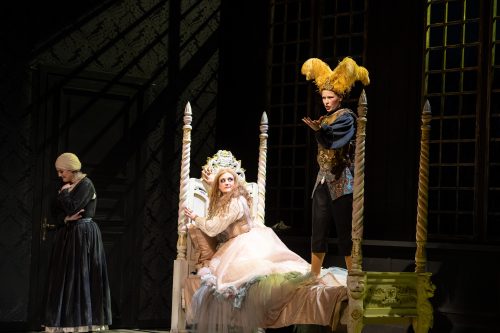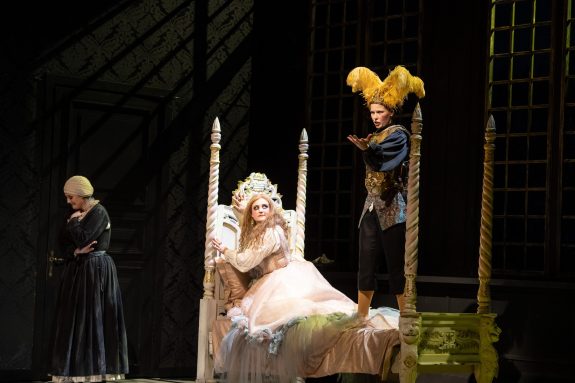 Germany Mozart, Le nozze di Figaro: Soloists, Chorus and Extras of Staatsoper Hannover. Niedersächsisches Staatsorchester Hannover / Mazaru Kumakura (conductor). Staatsoper Hannover, 19.5.2024. (DM-D)
Germany Mozart, Le nozze di Figaro: Soloists, Chorus and Extras of Staatsoper Hannover. Niedersächsisches Staatsorchester Hannover / Mazaru Kumakura (conductor). Staatsoper Hannover, 19.5.2024. (DM-D)

Production:
Director – Lydia Steier
Revival director – Valérie Junker
Stage design and Video – Momme Hinrichs
Costume design – Alfred Mayerhofer
Lighting design – Elana Siberski
Dramaturgy – Martin Mutschler
Chorus director – Lorenzo Da Rio
Cast:
Figaro – Richard Walshe
Susanna – Ketevan Chuntishvili
Count Almaviva – Darwin Prakash
Countess Almaviva – Kiandra Howarth
Cherubino – Nina van Essen
Marcellina – Ruzana Grigorian
Bartolo – Yannick Spanier
Basilio – Philipp Kapeller
Don Curzio – Fabio Dorizzi
Barbarina – Luisa Mordel
Antonio – Frank Schneiders
When the curtain rose on this production we saw all possible couples of the opera lined up at the ramp: they were all immobile, except for Susanna. The Count was kneeling at the Countess’s side. The orchestra started with a few bars leading up to Count Almaviva’s apology to his wife, ‘Contessa perdono’ which actually occurs at the end of the opera. The music and singing were extremely slow. Without the Countess’s response, the music slowly merged into the first bars of the overture, now presented at normal speed. The curtain closed, with all but Susanna disappearing from view: she had been placed in a spotlight of her own from the start, and until the end of the performance she remained on the stage, observing the action she was not involved in directly, and clearly showing her emotional response to what she saw: smiling, frowning, looking sad, amused, annoyed, or disappointed.
The world she was part of and commented on in this way was a decaying Rococo one, its obvious former splendour falling to pieces. The set by Momme Hinrichs foregrounded grey colours and crumbling structures, complemented well by the worn-out colours of the costumes by Alfred Mayerhofer. Director Lydia Steier convinced with consistent attention to the detail of the characters and their relationships. Count Almaviva was bored out of his mind and truly sex-obsessed (as were most of the male characters: in this production, some laughter was created repeatedly by a male character having to cover their trousers so that others, who had appeared unexpectedly, could not see their bulges). When Almaviva apologised to his wife (at the end of the opera) the apology was preceded by a long passage of exaggerated loud crying leading to hysterical laughter. Darwin Prakash had a very flexible voice for the Count, allowing full expression of the music in recitatives and arias.

Countess Almaviva was far from a desirable woman, adding to the despair ringing out from the Count’s apology: she had become a hypochondriac, always in bed, attended by two nuns (both in wheelchairs, one of them died in the course the opera) and Susanna. Other maidservants washed her, while she was still wearing her nightgown, against much resistance, and changed her apparently soiled bedclothes (looking at the sheets aghast, pointing at them to each other, and the weakest was given the task of removing the sheets while she and the others held their noses in disgust). The servants helped her into her clothes (which she put on over her nightgown) and administered oxygen from a hand-pump container. She wore garishly white make-up with darkish-red rings around her eyes. Kiandra Howarth proved an admirable actress for this role. Her voice was suited well to the character – not the well-rounded, honey-toned sounds usually associated and admired for the Countess, but much harder, edgier, sharper in articulation without ever turning shrill. For that reason, her voice was also much more in contrast with Susanna’s, as played and sung by Ketevan Chuntishvili, Susanna was the observer of events and characters, while at the same time fully involved in those events. In recitatives and duets, she was lively and forthright, with an agile, light voice. Her ‘Deh vieni’ was one of the evening’s highlights, reflecting deep, genuine love for Figaro both as the basis of her teasing him, and as the source of strength she so urgently needs in view of all the calamity she observes.
Richard Walshe as Figaro has developed as a company member of Staatsoper Hannover from a range of smaller roles to leading ones like this. He approaches the part with caution rather than abandon, testing the waters over a sustained three-hour duration rather giving it his all for a few minutes here and there. The performance fully justified the casting decision, there is ample vocal material there already, with more ahead: growing confidence will allow Walshe to further develop his voice’s range and nuances.
Nina van Essen was brilliant as Cherubino: her acting was imaginative and her voice – with excellent control of her vibrato – firm, smooth, and very nuanced. Ruzana Grigorian as Marcellina and Yannick Spanier as Bartolo acted their much older characters very well; their young, fresh and promising voices allowed for these characters to come to the fore in their music as well. Philipp Kapeller was very funny indeed as Basilio, relishing his music too. The few lines given to Barbarina made me want to hear more of soprano Luisa Mordel, who is a member of the Staatsoper Hannover’s International Opera Studio. Fabio Dorizzi as Don Curzio and Frank Schneiders as Antonio rounded off a very good cast.
The chorus was directed well by Lorenzo Da Rio, members knew what they were doing and why, and their singing stood out with a good degree of unison. Mazaru Kumakura led the orchestra in a playful, light-hearted interpretation of the score, which created an interesting tension with the darker elements of the production.
Daniel Meyer-Dinkgräfe
